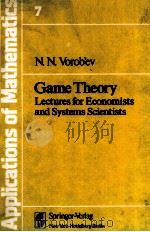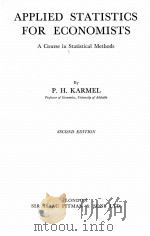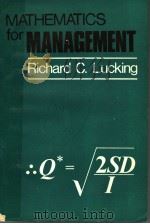《MATHEMATICS FOR ECONOMISTS》
| 作者 | CARL P.SIMON LAWRENCE BLUME 编者 |
|---|---|
| 出版 | W.W.NORTON & COMPANY |
| 参考页数 | 930 |
| 出版时间 | 1994(求助前请核对) 目录预览 |
| ISBN号 | 9780393957334 — 求助条款 |
| PDF编号 | 813733258(仅供预览,未存储实际文件) |
| 求助格式 | 扫描PDF(若分多册发行,每次仅能受理1册) |

PARTⅠIntroduction3
1Introduction3
1.1 MATHEMATICS IN ECONOMIC THEORY3
1.2MODELS OF CONSUMER CHOICE5
Two-Dimensional Model of Consumer Choice5
Multidimensional Model of Consumer Choice9
2One-Variable Calculus:Foundations10
2.1FUNCTIONS ON R110
Vocabulary of Functions10
Polynomials11
Graphs12
Increasing and Decreasing Functions12
Domain14
Interval Notation15
2.2LINEAR FUNCTIONS16
The Slope of a Line in the Plane16
The Equation of a Line19
Polynomials of Degree One Have Linear Graphs19
Interpreting the Slope of a Linear Function20
2.3 THE SLOPE OF NONLINEAR FUNCTIONS22
2.4COMPUTING DERIVATIVES25
Rules for Computing Derivatives27
2.5DIFFERENTIABILITY AND CONTINUITY29
A Nondifferentiable Function30
Continuous Functions31
Continuously Differentiable Functions32
2.6 HIGHER-ORDER DERIVATIVES33
2.7 APPROXIMATION BY DIFFERENTIALS34
3One-Variable Calculus:Applications39
3.1USING THE FIRST DERIVATIVE FOR GRAPHING39
Positive Derivative Implies Increasing Function39
Using First Derivatives to Sketch Graphs41
3.2 SECOND DERIVATIVES AND CONVEXITY43
3.3GRAPHING RATIONAL FUNCTIONS47
Hints for Graphing48
3.4TAILS AND HORIZONTAL ASYMPTOTES48
Tails of Polynomials48
Horizontal Asymptotes of Rational Functions49
3.5MAXIMA AND MINIMA51
Local Maxima and Minima on the Boundary and in the Interior51
Second Order Conditions53
Global Maxima and Minima55
Functions with Only One Critical Point55
Functions with Nowhere-Zero Second Derivatives56
Functions with No Global Max or Min56
Functions Whose Domains Are Closed Finite Intervals56
3.6APPLICATIONS TO ECONOMICS58
Production Functions58
Cost Functions59
Revenue and Profit Functions62
Demand Functions and Elasticity64
4One-Variable Calculus:Chain Rule70
4.1COMPOSITE FUNCTIONS AND THE CHAIN RULE70
Composite Functions70
Differentiating Composite Functions:The Chain Rule72
4.2INVERSE FUNCTIONS AND THEIR DERIVATIVES75
Deffnition and Examples of the Inverse of a Function75
The Derivative of the Inverse Function79
The Derivative of x m/n80
5Exponents and Logarithms82
5.1 EXPONENTIAL FUNCTIONS82
5.2 THE NUMBER e85
5.3LOGARITHMS88
Base 10 Logarithms88
Base e Logarithms90
5.4 PROPERTIES OF EXP AND LOG91
5.5 DERIVATIVES OF EXP AND LOG93
5.6APPLICATIONS97
Present Value97
Annuities98
Optimal Holding Time99
Logarithmic Derivative100
PARTⅡLinear Algebra107
6Introduction to Linear Algebra107
6.1 LINEAR SYSTEMS107
6.2EXAMPLES OF LINEAR MODELS108
Example 1:Tax Benefits of Charitable Contributions108
Example 2:Linear Models of Production110
Example 3:Markov Models of Employment113
Example 4:IS-LM Analysis115
Example 5:Investment and Arbitrage117
7Systems of Linear Equations122
7.1GAUSSIAN AND GAUSS-JORDAN ELIMINATION122
Substitution123
Elimination of Variables125
7.2 ELEMENTARY ROW OPERATIONS129
7.3 SYSTEMS WITH MANY OR NO SOLUTIONS134
7.4RANK—THE FUNDAMENTAL CRITERION142
Application to Portfolio Theory147
7.5 THE LINEAR IMPLICIT FUNCTION THEOREM150
8Matrix Algebra153
8.1MATRIX ALGEBRA153
Addition153
Subtraction154
Scalar Multiplication155
Matrix Multiplication155
Laws of Matrix Algebra156
Transpose157
Systems of Equations in Matrix Form158
8.2 SPECIAL KINDS OF MATRICES160
8.3 ELEMENTARY MATRICES162
8.4 ALGEBRA OF SQUARE MATRICES165
8.5INPUT- OUTPUT MATRICES174
Proof of Theorem 8.13178
8.6 PARTITIONED MATRICES (optional)180
8.7DECOMPOSING MATRICES (optional)183
Mathematical Induction185
Including Row Interchanges185
9Determinants:An Overview188
9.1THE DETERMINANT OF A MATRIX189
Defining the Determinant189
Computing the Determinant191
Main Property of the Determinant192
9.2 USES OF THE DETERMINANT194
9.3 IS-LM ANALYSIS VIA CRAMER’S RULE197
10Euclidean Spaces199
10.1 POINTS AND VECTORS IN EUCLIDEAN SPACE199
The Real Line199
The Plane199
Three Dimensions and More201
10.2 VECTORS202
10.3 THE ALGEBRA OF VECTORS205
Addition and Subtraction205
Scalar Multiplication207
10.4 LENGTH AND INNER PRODUCT IN Rn209
Length and Distance209
The Inner Product213
10.5LINES222
10.6PLANES226
Parametric Equations226
Nonparametric Equations228
Hyperplanes230
10.7ECONOMIC APPLICATIONS232
Budget Sets in Commodity Space232
Input Space233
Probability Simplex233
The Investment Model234
IS-LM Analysis234
11Linear Independence237
11.1LINEAR INDEPENDENCE237
Definition238
Checking Linear Independence241
11.2 SPANNING SETS244
11.3BASIS AND DIMENSION IN Rn247
Dimension249
11.4 EPILOGUE249
PARTⅢCalculus of Several Variables253
12Limits and Open Sets253
12.1SEQUENCES OF REAL NUMBERS253
Definition253
Limit of a Sequence254
Algebraic Properties of Limits256
12.2 SEQUENCES IN Rm260
12.3OPEN SETS264
Interior of a Set267
12.4CLOSED SETS267
Closure of a Set268
Boundary of a Set269
12.5 COMPACT SETS270
12.6 EPILOGUE272
13Functions of Several Variables273
13.1FUNCTIONS BETWEEN EUCLIDEAN SPACES273
Functions from Rn to R274
Functions from Rk to Rm275
13.2GEOMETRIC REPRESENTATION OF FUNCTIONS277
Graphs of Functions of Two Variables277
Level Curves280
Drawing Graphs from Level Sets281
Planar Level Sets in Economics282
Representing Functions from Rk to Rl for k > 2283
Images of Functions from R1 to Rm285
13.3SPECIAL KINDS OF FUNCTIONS287
Linear Functions on Rk287
Quadratic Forms289
Matrix Representation of Quadratic Forms290
Polynomials291
13.4 CONTINUOUS FUNCTIONS293
13.5VOCABULARY OF FUNCTIONS295
Onto Functions and One-to-One Functions297
Inverse Functions297
Composition of Functions298
14Calculus of Several Variables300
14.1 DEFINITIONS AND EXAMPLES300
14.2ECONOMIC INTERPRETATION302
Marginal Products302
Elasticity304
14.3 GEOMETRIC INTERPRETATION305
14.4THE TOTAL DERIVATIVE307
Geometric Interpretation308
Linear Approximation310
Functions of More than Two Variables311
14.5THE CHAIN RULE313
Curves313
Tangent Vector to a Curve314
Differentiating along a Curve:The Chain Rule316
14.6DIRECTIONAL DERIVATIVES AND GRADIENTS319
Directional Derivatives319
The Gradient Vector320
14.7EXPLICIT FUNCTIONS FROM Rn TO Rm323
Approximation by Differentials324
The Chain Rule326
14.8HIGHER-ORDER DERIVATIVES328
Continuously Differentiable Functions328
Second Order Derivatives and Hessians329
Young’s Theorem330
Higher-Order Derivatives331
An Economic Application331
14.9 Epilogue333
15Implicit Functions and Their Derivatives334
15.1IMPLICIT FUNCTIONS334
Examples334
The Implicit Function Theorem for R2337
Several Exogenous Variables in an Implicit Function341
15.2LEVEL CURVES AND THEIR TANGENTS342
Geometric Interpretation of the Implicit Function Theorem342
Proof Sketch344
Relationship to the Gradient345
Tangent to the Level Set Using Differentials347
Level Sets of Functions of Several Variables348
15.3SYSTEMS OF IMPLICIT FUNCTIONS350
Linear Systems351
Nonlinear Systems353
15.4 APPLICATION:COMPARATIVE STATICS360
15.5 THE INVERSE FUNCTION THEOREM (optional)364
15.6 APPLICATION:SIMPSON’S PARADOX368
PARTⅣOptimization375
16Quadratic Forms and Definite Matrices375
16.1 QUADRATIC FORMS375
16.2DEFINITENESS OF QUADRATIC FORMS376
Definite Symmetric Matrices379
Application:Second Order Conditions and Convexity379
Application:Conic Sections380
Principal Minors of a Matrix381
The Definiteness of Diagonal Matrices383
The Definiteness of 2 × 2 Matrices384
16.3LINEAR CONSTRAINTS AND BORDERED MATRICES386
Definiteness and Optimality386
One Constraint390
Other Approaches391
16.4 APPENDIX393
17Unconstrained Optimization396
17.1 DEFINITIONS396
17.2 FIRST ORDER CONDITIONS397
17.3SECOND ORDER CONDITIONS398
Sufficient Conditions398
Necessary Conditions401
17.4GLOBAL MAXIMA AND MINIMA402
Global Maxima of Concave Functions403
17.5ECONOMIC APPLICATIONS404
Profit-Maximizing Firm405
Discriminating Monopolist405
Least Squares Analysis407
18Constrained Optimization Ⅰ:First Order Conditions411
18.1 EXAMPLES412
18.2EQUALITY CONSTRAINTS413
Two Variables and One Equality Constraint413
Several Equality Constraints420
18.3INEQUALITY CONSTRAINTS424
One Inequality Constraint424
Several Inequality Constraints430
18.4 MIXED CONSTRAINTS434
18.5 CONSTRAINED MINIMIZATION PROBLEMS436
18.6 KUHN-TUCKER FORMULATION439
18.7EXAMPLES AND APPLICATIONS442
Application:A Sales-Maximizing Firm with Advertising442
Application:The Averch-Johnson Effect443
One More Worked Example445
19Constrained Optimization Ⅱ448
19.1THE MEANING OF THE MULTIPLIER448
One Equality Constraint449
Several Equality Constraints450
Inequality Constraints451
Interpreting the Multiplier452
19.2ENVELOPE THEOREMS453
Unconstrained Problems453
Constrained Problems455
19.3SECOND ORDER CONDITIONS457
Constrained Maximization Problems459
Minimization Problems463
Inequality Constraints466
Alternative Approaches to the Bordered Hessian Condition467
Necessary Second Order Conditions468
19.4 SMOOTH DEPENDENCE ON THE PARAMETERS469
19.5 CONSTRAINT QUALIFICATIONS472
19.6PROOFS OF FIRST ORDER CONDITIONS478
Proof of Theorems 18.1 and 18.2:Equality Constraints478
Proof of Theorems 18.3 and 18.4:Inequality Constraints480
2 0Homogeneous and Homothetic Functions483
20.1HOMOGENEOUS FUNCTIONS483
Definition and Examples483
Homogeneous Functions in Economics485
Properties of Homogeneous Functions487
A Calculus Criterion for Homogeneity491
Economic Applications of Euler’s Theorem492
20.2HOMOGENIZING A FUNCTION493
Economic Applications of Homogenization495
20.3 CARDINAL VERSUS ORDINAL UTILITY496
20.4HOMOTHETIC FUNCTIONS500
Motivation and Definition500
Characterizing Homothetic Functions501
21Concave and Quasiconcave Functions505
21.1CONCAVE AND CONVEX FUNCTIONS505
Calculus Criteria for Concavity509
21.2PROPERTIES OF CONCAVE FUNCTIONS517
Concave Functions in Economics521
21.3QUASICONCAVE AND QUASICONVEX FUNCTIONS522
Calculus Criteria525
21.4 PSEUDOCONCAVE FUNCTIONS527
21.5CONCAVE PROGRAMMING532
Unconstrained Problems532
Constrained Problems532
Saddle Point Approach534
21.6APPENDIX537
Proof of the Sufficiency Test of Theorem 21.14537
Proof of Theorem 21.15538
Proof of Theorem 21.17540
Proof of Theorem 21.20541
22Economic Applications544
22.1UTILITY AND DEMAND544
Utility Maximization544
The Demand Function547
The Indirect Utility Function551
The Expenditure and Compensated Demand Functions552
The Slutsky Equation555
22.2ECONOMIC APPLICATION:PROFIT AND COST557
The Profit-Maximizing Firm557
The Cost Function560
22.3PARETO OPTIMA565
Necessary Conditions for a Pareto Optimum566
Sufficient Conditions for a Pareto Optimum567
22.4 THE FUNDAMENTAL WELFARE THEOREMS569
Competitive Equilibrium572
Fundamental Theorems of Welfare Economics573
PARTⅤ Eigenvalues and Dynamics579
23Eigenvalues and Eigenvectors579
23.1 DEFINITIONS AND EXAMPLES579
23.2SOLVING LINEAR DIFFERENCE EQUATIONS585
One-Dimensional Equations585
Two-Dimensional Systems:An Example586
Conic Sections587
The Leslie Population Model588
Abstract Two-Dimensional Systems590
K-Dimensional Systems591
An Alternative Approach:The Powers of a Matrix594
Stability of Equilibria596
23.3PROPERTIES OF EIGENVALUES597
Trace as Sum of the Eigenvalues599
23.4REPEATED EIGENVALUES601
2 × 2 Nondiagonalizable Matrices601
3 × 3 Nondiagonalizable Matrices604
Solving Nondiagonalizable Difference Equations606
23.5COMPLEX EIGENVALUES AND EIGENVECTORS609
Diagonalizing Matrices with Complex Eigenvalues609
Linear Difference Equations with Complex Eigenvalues611
Higher Dimensions614
23.6 MARKOV PROCESSES615
23.7 SYMMETRIC MATRICES620
23.8 DEFINITENESS OF QUADRATIC FORMS626
23.9APPENDIX629
Proof of Theorem 23.5629
Proof of Theorem 23.9630
24Ordinary Differential Equations:Scalar Equations633
24.1 DEFINITION AND EXAMPLES633
24.2EXPLICIT SOLUTIONS639
Linear First Order Equations639
Separable Equations641
24.3LINEAR SECOND ORDER EQUATIONS647
Introduction647
Real and Unequal Roots of the Characteristic Equation648
Real and Equal Roots of the Characteristic Equation650
Complex Roots of the Characteristic Equation651
The Motion of a Spring653
Nonhomogeneous Second Order Equations654
24.4EXISTENCE OF SOLUTIONS657
The Fundamental Existence and Uniqueness Theorem657
Direction Fields659
24.5PHASE PORTRAITS AND EQUILIBRIA ON R1666
Drawing Phase Portraits666
Stability of Equilibria on the Line668
24.6APPENDIX:APPLICATIONS670
Indirect Money Metric Utility Functions671
Converse of Euler’s Theorem672
25Ordinary Differential Equations:Systems of Equations674
25.1PLANAR SYSTEMS:AN INTRODUCTION674
Coupled Systems of Differential Equations674
Vocabulary676
Existence and Uniqueness677
25.2LINEAR SYSTEMS VIA EIGENVALUES678
Distinct Real Eigenvalues678
Complex Eigenvalues680
Multiple Real Eigenvalues681
25.3 SOLVING LINEAR SYSTEMS BY SUBSTITUTION682
25.4STEADY STATES AND THEIR STABILITY684
Stability of Linear Systems via Eigenvalues686
Stability of Nonlinear Systems687
25.5PHASE PORTRAITS OF PLANAR SYSTEMS689
Vector Fields689
Phase Portraits:Linear Systems692
Phase Portraits:Nonlinear Systems694
25.6FIRST INTEGRALS703
The Predator-Prey System705
Conservative Mechanical Systems707
25.7 LIAPUNOV FUNCTIONS711
25.8 APPENDIX:LINEARIZATION715
PARTⅥ Advanced Linear Algebra719
26Determinants:The Details719
26.1 DEFINITIONS OF THE DETERMINANT719
26.2 PROPERTIES OF THE DETERMINANT726
26.3USING DETERMINANTS735
The Adjoint Matrix736
26.4ECONOMIC APPLICATIONS739
Supply and Demand739
26.5APPENDIX743
Proof of Theorem 26.1743
Proof of Theorem 26.9746
Other Approaches to the Determinant747
27Subspaces Attached to a Matrix750
27.1VECTOR SPACES AND SUBSPACES750
Rn as a Vector Space750
Subspaces of Rn751
27.2 BASIS AND DIMENSION OF A PROPER SUBSPACE755
27.3 ROW SPACE757
27.4COLUMN SPACE760
Dimension of the Column Space of A760
The Role of the Column Space763
27.5NULLSPACE765
Affine Subspaces765
Fundamental Theorem of Linear Algebra767
Conclusion770
27.6 ABSTRACT VECTOR SPACES771
27.7APPENDIX774
Proof of Theorem 27.5774
Proof of Theorem 27.10775
28Applications of Linear Independence779
28.1GEOMETRY OF SYSTEMS OF EQUATIONS779
Two Equations in Two Unknowns779
Two Equations in Three Unknowns780
Three Equations in Three Unknowns782
28.2 PORTFOLIO ANALYSIS783
28.3VOTING PARADOXES784
Three Alternatives785
Four Alternatives788
Consequences of the Existence of Cycles789
Other Voting Paradoxes790
Rankings of the Quality of Firms790
28.4ACTIVITY ANALYSIS:FEASIBILITY791
Activity Analysis791
Simple Linear Models and Productive Matrices793
28.5ACTIVITY ANALYSIS:EFFICIENCY796
Leontief Models796
PARTⅦ Advanced Analysis803
29Limits and Compact Sets803
29.1 CAUCHY SEQUENCES803
29.2 COMPACT SETS807
29.3 CONNECTED SETS809
29.4ALTERNATIVE NORMS811
Three Norms on Rn811
Equivalent Norms813
Norms on Function Spaces815
29.5APPENDIX816
Finite Covering Property816
Heine-Borel Theorem817
Summary820
30Calculus of Several Variables Ⅱ822
30.1WEIERSTRASS’S AND MEAN VALUE THEOREMS822
Existence of Global Maxima on Compact Sets822
Rolle’s Theorem and the Mean Value Theorem824
30.2TAYLOR POLYNOMIALS ON R1827
Functions of One Variable827
30.3 TAYLOR POLYNOMIALS IN Rn832
30.4SECOND ORDER OPTIMIZATION CONDITIONS836
Second Order Sufficient Conditions for Optimization836
Indefinite Hessian839
Second Order Necessary Conditions for Optimization840
30.5 CONSTRAINED OPTIMIZATION841
PARTⅧAppendices847
A1Sets,Numbers,and Proofs847
A1.1SETS847
Vocabulary of Sets847
Operations with Sets847
A1.2NUMBERS848
Vocabulary848
Properties of Addition and Multiplication849
Least Upper Bound Property850
A1.3PROOFS851
Direct Proofs851
Converse and Contrapositive853
Indirect Proofs854
Mathematical Induction855
A2Trigonometric Functions859
A2.1 DEFINITIONS OF THE TRIG FUNCTIONS859
A2.2 GRAPHING TRIG FUNCTIONS863
A2.3 THE PYTHAGOREAN THEOREM865
A2.4 EVALUATING TRIGONOMETRIC FUNCTIONS866
A2.5 MULTIANGLE FORMULAS868
A2.6 FUNCTIONS OF REAL NUMBERS868
A2.7 CALCULUS WITH TRIG FUNCTIONS870
A2.8 TAYLOR SERIES872
A2.9 PROOF OF THEOREM A2.3873
A3Complex Numbers876
A3.1BACKGROUND876
Denitions877
Arithmetic Operations877
A3.2 SOLUTIONS OF POLYNOMIAL EQUATIONS878
A3.3 GEOMETRIC REPRESENTATION879
A3.4 COMPLEX NUMBERS AS EXPONENTS882
A3.5 DIFFERENCE EQUATIONS884
A4Integral Calculus887
A4.1ANTIDERIVATIVES887
Integration by Parts888
A4.2 THE FUNDAMENTAL THEOREM OF CALCULUS889
A4.3APPLICATIONS890
Area under a Graph890
Consumer Surplus891
Present Value of a Flow892
A5Introduction to Probability894
A5.1 PROBABILITY OF AN EVENT894
A5.2 EXPECTATION AND VARIANCE895
A5.3 CONTINUOUS RANDOM VARIABLES896
A6 Selected Answers899
Index921
1994《MATHEMATICS FOR ECONOMISTS》由于是年代较久的资料都绝版了,几乎不可能购买到实物。如果大家为了学习确实需要,可向博主求助其电子版PDF文件(由CARL P.SIMON LAWRENCE BLUME 1994 W.W.NORTON & COMPANY 出版的版本) 。对合法合规的求助,我会当即受理并将下载地址发送给你。
高度相关资料
-

- Applied statistics for economists 3rd ed.
- 1970 Pitman
-

- EXPERIMENTAL METHODS:A PRIMER FOR ECONOMISTS
- 1994 CAMBRIDGE UNIVERSITY PRESS
-

- MATHEMATICS FOR COMPUTERS
- 1986 MCGRAW-HILL BOOK COMPANY
-

- GAME THEORY LECTURES FOR ECONOMISTS AND SYSTEMS SCIENTISTS
- 1977 SPRINGER-VERLAG
-

- STATISTICS FOR ECONOMISTS
- 1953 HUTCHINSON’S UNIVERSITY LIBRARY
-

- APPLIED STATISTICS FOR ECONOMISTS SECOND EDITION
- 1957 SIR ISAAC PITMAN & SONS LTD.
-

- TOPICS IN MATHEMATICAL ANALYSIS FOR ECONOMISTS
- 1981 ACADEMIC PERSS
提示:百度云已更名为百度网盘(百度盘),天翼云盘、微盘下载地址……暂未提供。➥ PDF文字可复制化或转WORD







